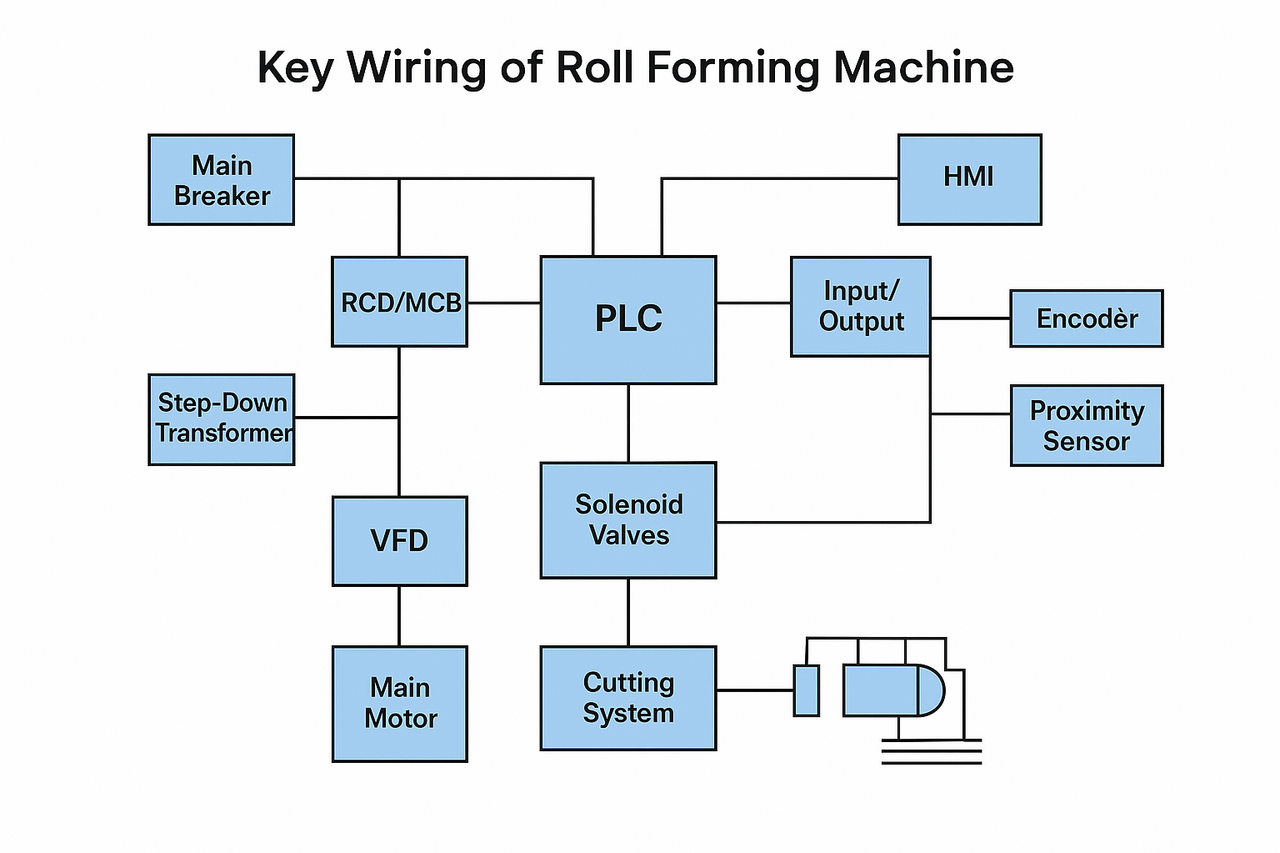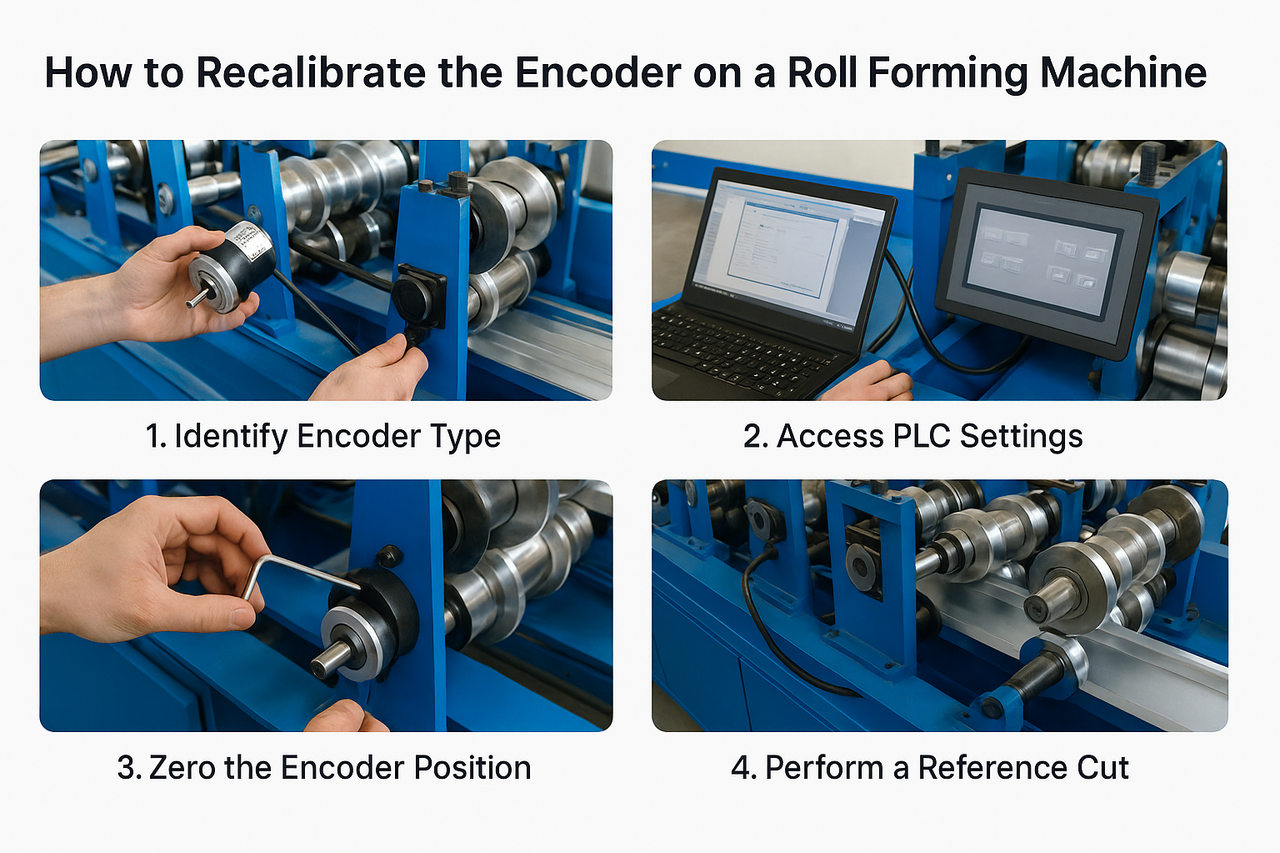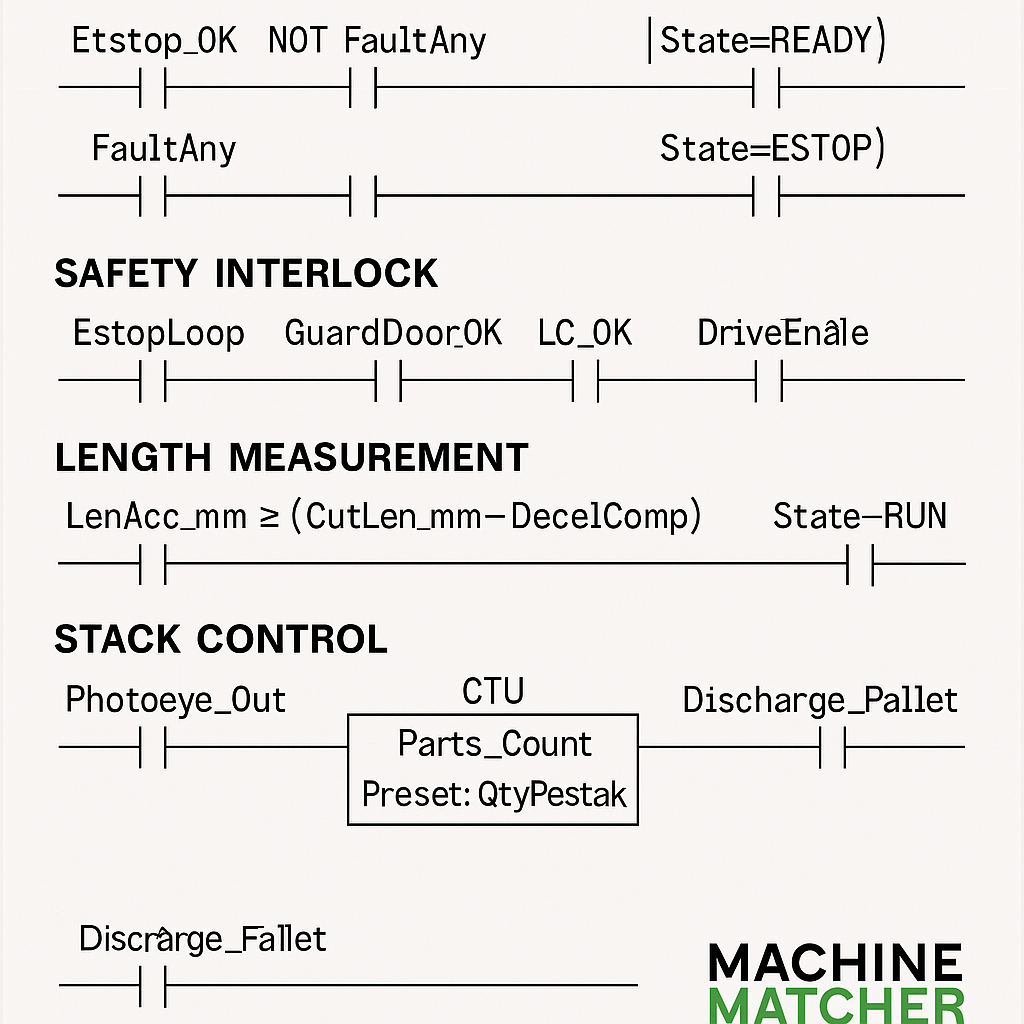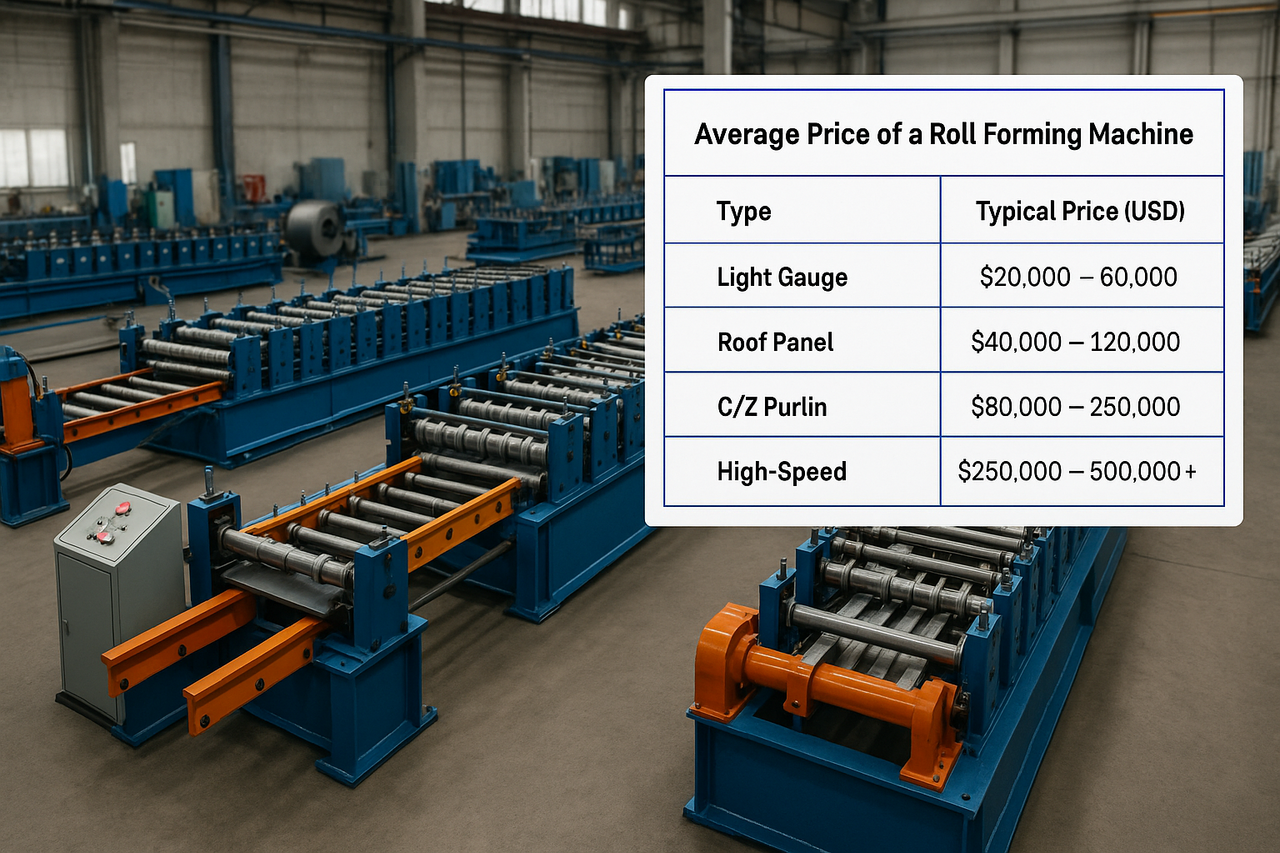
Posted on Tuesday, November 11, 2025
Roll forming machines are the backbone of modern metal fabrication, enabling the production of precise, repeatable, and high-strength profiles for roofing, cladding, framing, decking, and countless industrial applications.
At Machine Matcher, we supply and support a complete range of new roll forming machines built to customer specifications, helping manufacturers across more than 170 countries produce metal profiles for construction, automotive, infrastructure, and renewable-energy projects.
This guide explores the most common types of roll forming machines, their uses, specifications, materials, and key industries they serve — giving you the insight to select the perfect model for your business.
Each roll forming machine is engineered for a specific purpose. Some are designed for thin-gauge roofing panels; others can shape 3- or 4-mm steel for purlins or decking. While all machines follow the same basic process — feeding a continuous coil through roller stations — their tooling, speed, drive systems, and cutting technologies vary widely.
Choosing the correct machine type ensures:
Consistent product dimensions
Long tool life
High throughput
Compatibility with local materials and market demand
Roofing roll formers are among the most common and versatile machines. They produce corrugated, trapezoidal, or ribbed panels used for residential, industrial, and commercial roofing systems.
Metal roof sheets for houses, factories, and warehouses
Wall cladding panels
Agricultural storage buildings
Material: Galvanized, galvalume, or pre-painted steel (0.3–0.8 mm thick)
Speed: 10–30 m/min
Stations: 12–18 forming rollers
Cutting: Hydraulic guillotine or fly-cut
Power: 380 V / 50 Hz / 3-phase (customizable)
Simple operation
Fast profile change options
Low maintenance
Roofing machines remain the top choice for start-up manufacturers due to their affordability and wide product demand.
Standing seam panels are premium architectural roofing systems that use concealed fasteners for weather-tightness and clean aesthetics. The roll forming machine shapes male and female seam edges for mechanical or snap-lock joints.
Precision servo feed and cutting for tight tolerances
Option for portable or in-plant versions
Adjustable width tooling for multiple panel styles
Material: Galvanized or aluminum (0.4–0.8 mm)
Rollers: Hardened GCr15 steel
Control: PLC with touchscreen
Speed: 12–20 m/min
Architectural roofing, commercial buildings, and standing-seam solar mounting projects.
C/Z purlin machines produce structural steel sections used to support roof and wall sheeting. They are heavier-duty systems built to handle thicker materials.
Material Thickness: 1.5–3.0 mm
Material Strength: 550 MPa or higher
Speed: 15–25 m/min
Cutting: Hydraulic or flying cut-off
Drive: Gearbox or direct drive
Automatic size change (C to Z conversion without roller adjustment)
Punching and notching units integrated before forming
Steel building frames, warehouses, industrial sheds, and solar structure fabrication.
High structural strength
Quick size change reduces downtime
Produces standardized international sections (C100–C300, Z100–Z300)
Light-gauge framing (LGS) systems rely on stud and track roll formers to create wall and ceiling framing components.
Material Thickness: 0.45–1.2 mm
Material Type: Galvanized steel
Speed: Up to 40 m/min
Stations: 10–16
Cutting: Servo-driven hydraulic or pneumatic system
Compact size for factory or on-site use
Automated length and punching control
Excellent for drywall contractors and prefabricated building companies
Residential and commercial construction, modular housing, and interior framing systems.
Metal deck machines produce high-strength floor and roof decking profiles used in composite slab systems and multi-storey buildings.
Material Thickness: 0.8–1.5 mm
Material Strength: Up to 550 MPa
Speed: 12–20 m/min
Stations: 24–36 forming stages
Cutting: Hydraulic fly-cut system
1.5" B-Deck
2" and 3" N-Deck
Deep rib roof deck
Excellent load-bearing capacity
Precise interlocking profiles
Fire-resistant composite flooring when used with concrete
Tube mills roll-form strip steel into circular, square, or rectangular tubing before welding and sizing.
High-frequency (HF) welding unit
Sizing section and flying saw cutter
Diameter range from 12 mm to 150 mm
Furniture tubing, automotive frames, structural supports, and conduit manufacturing.
Material Thickness: 0.5–4.0 mm
Speed: 20–80 m/min
Drive: Gearbox with individual motorized stands
High-volume continuous production
Suitable for both carbon steel and stainless materials
These machines produce light or heavy-duty angles, channels, or furring sections used in various industries.
Material: Mild or galvanized steel
Thickness: 0.8–3.0 mm
Speed: 15–25 m/min
Drive: Chain or gearbox
Electrical cable trays, solar mounting channels, fence posts, and construction framing.
Channels can include pre-punching for assembly holes or slots.
Some applications demand unique profiles. Specialized machines are engineered for:
Gutters and Downspouts: Curved or K-style gutter sections with crimping.
Flashings and Trims: Drip edge, rake trim, or apron flashing machines.
Door and Window Frames: Steel door jamb and casing roll formers.
Highway Guardrails: 2- or 3-wave beam sections.
Automotive Parts: Structural reinforcements, bumper beams, or seat tracks.
Each specialized line includes punching, notching, and sometimes embossing units for branding or reinforcement.
| Industry | Common Machine Types | Typical Materials | Notes |
|---|---|---|---|
| Construction | Roofing, Decking, Purlin | GI / PPGI | High demand in developing regions |
| Automotive | Tube Mills, Structural Roll Formers | Carbon & HSLA steel | Requires precision tooling |
| Energy & Utilities | Cable Tray, Solar Bracket, Guardrail | Galvanized / Aluminum | Corrosion-resistant finishes |
| Agriculture | Gutter, Downspout, Structural | Galvanized steel | Often thicker gauges |
| Infrastructure | Guardrail, Decking | High-tensile steel | Requires heavy frames |
Selecting by industry ensures you get the right combination of roller material, drive system, and line speed.
Despite differences in purpose, every roll forming line shares similar core elements:
Decoiler – Holds and feeds coil steel into the line.
Feeding Guide – Aligns the strip to prevent side drift.
Roller Stations – Gradually shape the material through successive passes.
Cutting Unit – Cuts to programmed length; may be stationary or flying.
Control System (PLC) – Automates feeding, cutting, and fault detection.
Hydraulic Station – Powers cutting and punching units.
Output Table / Stacker – Collects finished profiles for packing.
High-quality machines use precision-engineered rollers made from GCr15 or Cr12Mov tool steel, hardened and polished for long life. Shafts are typically 45# steel (60–90 mm diameter) to prevent deflection under load.
Cheaper machines may use mild steel rollers, but these wear quickly, reducing accuracy. For continuous industrial production, hardened rollers and heavy-duty frames are essential.
| Machine Type | Average Speed | Automation Level | Typical Power |
|---|---|---|---|
| Roofing | 10–30 m/min | Semi or full PLC | 5–10 kW |
| Standing Seam | 12–20 m/min | Full PLC | 8–12 kW |
| Purlin | 15–25 m/min | Full PLC + Auto size change | 15–25 kW |
| Stud/Track | 30–40 m/min | Full PLC + Punching | 5–8 kW |
| Decking | 12–20 m/min | Full PLC | 20–30 kW |
| Tube Mill | 20–80 m/min | High automation | 40–80 kW |
Higher speed requires synchronized drives, servo control, and precise encoder systems to maintain cutting accuracy.
New Machines
Fully customizable for your profile
Modern PLC and servo systems
Warranty and technical support
Lower risk of downtime
Used Machines
Lower cost initially
Limited customization
May require re-tooling and maintenance
Machine Matcher supplies only new machines built to specification but can assist with sourcing or inspecting used machines on request.
Regardless of type, all roll forming machines benefit from preventive maintenance:
Clean rollers daily and remove debris.
Check oil levels in hydraulic units weekly.
Re-align encoder and roller shafts quarterly.
Replace seals and filters annually.
Machine Matcher provides maintenance plans, spare-parts supply, and remote PLC diagnostics through our 24/7 Global Technical Support Desk.
| Machine Type | Approx. Price Range (USD) |
|---|---|
| Roofing Roll Former | $25,000 – $80,000 |
| Standing Seam | $40,000 – $120,000 |
| C/Z Purlin Line | $80,000 – $250,000 |
| Stud & Track | $25,000 – $60,000 |
| Decking Line | $100,000 – $200,000 |
| Tube/Pipe Mill | $150,000 – $400,000 |
| Flashing / Gutter Line | $20,000 – $50,000 |
Prices vary depending on automation level, roller count, servo systems, and accessories such as stackers or uncoilers.
What is the most popular roll forming machine?
Roofing and C/Z purlin lines are the most common globally due to strong construction demand.
Can one machine make multiple profiles?
Yes — adjustable cassette systems allow multiple profile sets on one base.
Which machine is best for high-tensile steel?
Purlin, decking, or structural roll formers with hardened rollers and gearbox drives.
Are portable roll formers available?
Yes, especially for standing seam and stud/track production on job sites.
How long does it take to make one panel?
At 30 m/min, a 6-m roof sheet takes about 12 seconds to form.
Can Machine Matcher help with profile design?
Absolutely. Our engineers create or adapt drawings to your local market standards.
Roll forming machines are not one-size-fits-all. Roofing lines dominate entry-level manufacturing, while purlin, decking, and tube mills serve heavy industry. Each type has a defined purpose, and selecting the right one requires balancing material thickness, speed, and production goals.
Machine Matcher supplies new, customized roll forming machines engineered for your exact profile and power requirements. Every unit is tested before shipment and backed by our 24/7 technical support network across the UK, USA, and worldwide.
All machines are built new to your specifications and delivered globally.

Complete Guide to Roll Forming Machine Wiring and Control Panel Components
Posted on Tuesday, November 11, 2025
Learn the complete wiring layout and main panel components of a roll forming machine — including PLC, VFD, sensors, safety circuits, and controls.

How to Recalibrate the Encoder on a Roll Forming Machine
Posted on Tuesday, November 11, 2025
Learn how to recalibrate an encoder on roll forming machines to restore cutting accuracy and correct length errors.

The Ultimate PLC Automation Guide for Roll Forming Machines
Posted on Tuesday, November 11, 2025
A complete guide to PLC automation and ladder logic for roll forming machines — covering feeding, punching, flying shear, safety, and real code examples.

What is the Average Price of a Roll Forming Machine?
Posted on Tuesday, October 21, 2025
Discover the average price of roll forming machines by type, capacity, and automation level, with real examples and expert buying advice.
Copyright 2025 © Machine Matcher.